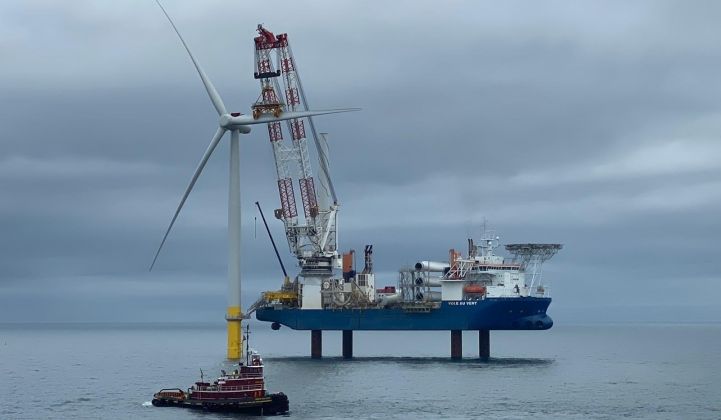Dominion Energy and its partner Ørsted have completed installation of the second offshore wind facility ever built in U.S. waters, the Coastal Virginia Offshore Wind pilot located 30 miles off Virginia Beach.
Dominion, a large utility group based in Virginia, announced Monday that both 6-megawatt (MW) Siemens Gamesa turbines are now in place, following the recent installation of the two monopile foundations that stick into the seabed. The turbines will undergo testing in the coming weeks before the project is fully energized later this summer, generating enough power for 3,000 homes in the state.
The Coastal Virginia pilot sets the stage for Dominion’s planned 2,600 MW follow-up at an adjacent project site — the largest offshore wind farm currently planned in American waters and the only such project owned entirely by a U.S. utility. The follow-up project is scheduled to enter construction in 2024 using the largest wind turbine ever released commercially, Siemens Gamesa’s new 14 MW model.
The outlook for the U.S. offshore wind market has changed dramatically since 2016, when the Block Island Wind Farm became the first project to cross the finish line off the coast of Rhode Island.
Both Block Island (30 MW) and the Coastal Virginia pilot (12 MW) are small and expensive; the Virginia project was expected to cost an eye-popping $300 million. (Dominion says its customers will not see any rate increases related to the project.)
The next wave of projects will be much larger and cheaper, including Ørsted's 132 MW South Fork site off New York and Vineyard Wind’s 800 MW development off Massachusetts, both due for completion in 2023 after recent delays.
Virginia chases offshore wind leadership role
Virginia’s utility regulator, the State Corporation Commission, reluctantly approved the Coastal Virginia pilot in 2018, citing concerns about the project’s cost. The electricity generated by Dominion’s Coastal Virginia pilot will be nine times as expensive as Vineyard Wind, with a forecast levelized cost of energy of 78 cents per kilowatt-hour, according to the regulator (PDF).
Since then, however, much has changed for U.S. offshore wind, including in Virginia. Earlier this year, Virginia passed the Clean Economy Act, requiring the state to eliminate all carbon from its electricity supply by 2045. The legislation includes a 5.2-gigawatt offshore wind target for 2034, putting Virginia behind only New York and New Jersey in current state offshore wind mandates. Dominion has said it wants to build nearly all of that capacity in Virginia.
“It’s interesting that the only thing [Dominion] has demonstrated so far is they could construct it — they’ve done nothing related to operations yet. And yet that’s good enough for state politicians,” said Max Cohen, principal analyst at Wood Mackenzie Power & Renewables.
“They feel there’s enough from lessons learned in other states and from Europe’s experience to really go full steam ahead, without much operating steel in the water in the U.S. yet," Cohen said. "There’s a confidence that this industry can deliver."
“I don’t think we’ll see the same kind of noise coming from the [State Corporation Commission] for Dominion’s next big project as the economies of scale really start kicking in."
Between Dominion’s pilot, its huge project to follow, and the natural advantages the Hampton Roads region has as a potential offshore wind hub, Virginia is hoping to woo manufacturers like Siemens Gamesa to its shores — an ambition that runs to the very top of the state’s political establishment.
The Coastal Virginia pilot “propels Virginia to national leadership in America’s transition to clean energy,” Governor Ralph Northam said in a statement. “It’s also shaping a new industry that will bring thousands of new clean energy jobs to Virginia.”
All of the major components for the Coastal Virginia pilot were imported from Europe, along with the specialized installation vessel.
Despite its small size, the Coastal Virginia pilot will hold a place in the industry’s history as the first project built in federal waters. Block Island was built in Rhode Island state waters just four miles from shore, allowing its developer to avoid the arduous multi-year federal permitting process.
“That does make [Coastal Virginia] a bit of a milestone: There’s so much promise in federal waters, and it’s finally being delivered,” said Cohen.
The U.S. government’s offshore wind lease program has awarded enough acreage to support as much as 30 gigawatts of capacity so far, with areas capable of holding as much as 45 gigawatts under consideration for future leasing, according to WoodMac.




